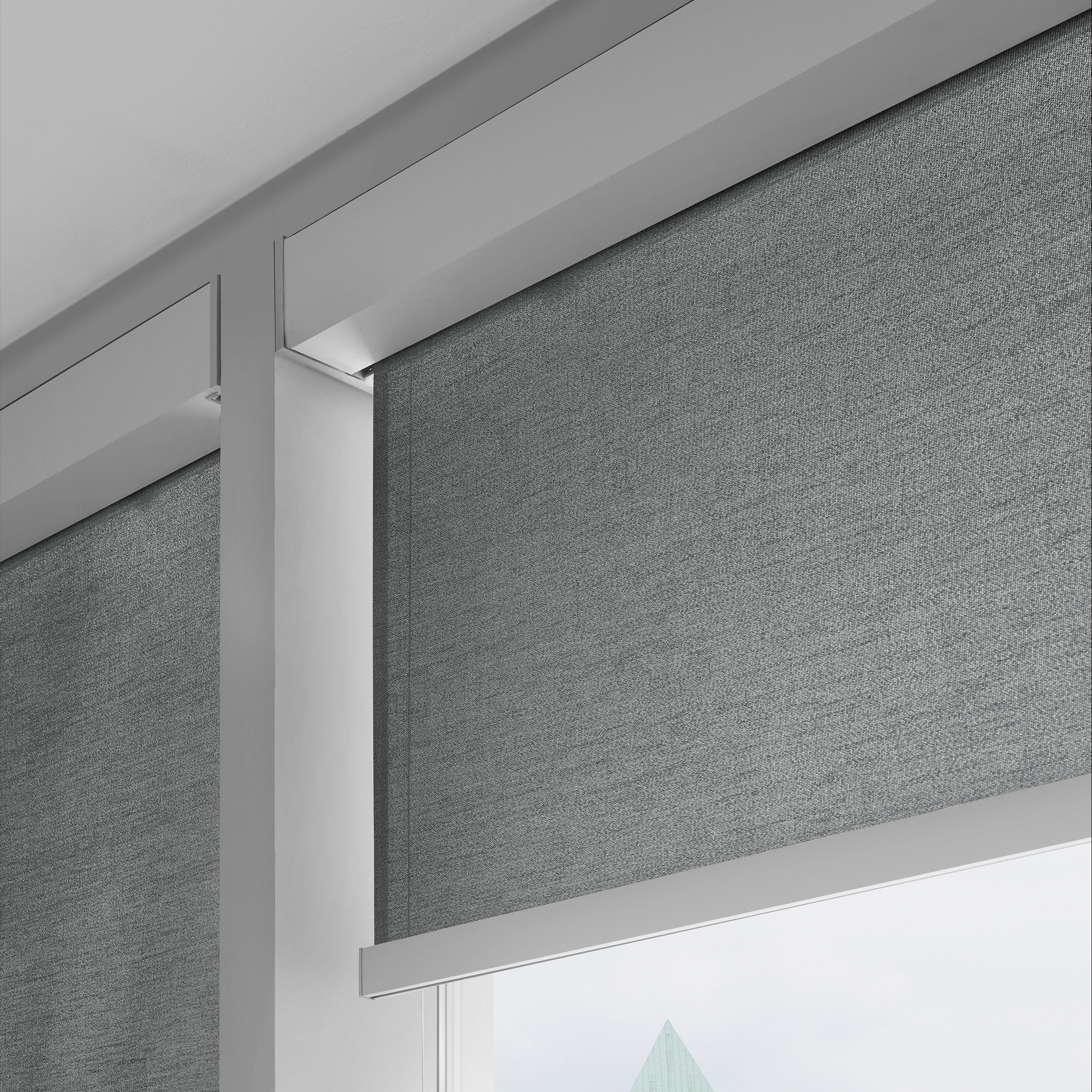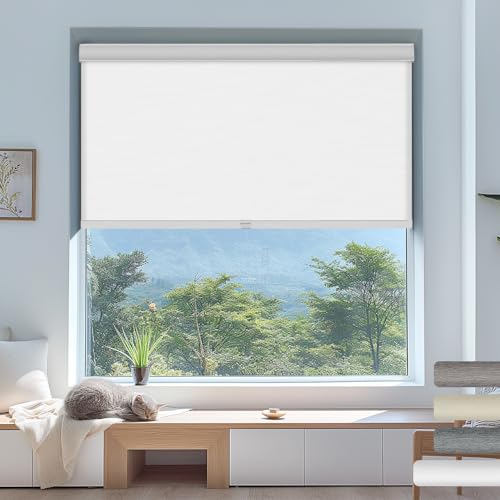Sunscreen roller blinds are a type of window covering designed to filter natural light while maintaining visibility and UV protection. They are made from a special sunscreen fabric that allows light to pass through while significantly reducing glare and blocking harmful UV rays. These blinds are ideal for spaces that require light management without completely blocking the view, such as living rooms, offices, or sunrooms.
Here's a detailed look at what sunscreen roller blinds are and how they differ from traditional roller blinds:
What are Sunscreen Roller Blinds?
Sunscreen roller blinds are made from a perforated or woven mesh-like fabric that:
- Filters sunlight: The fabric allows natural light to enter the room while minimizing glare.
- Reduces UV rays: Sunscreen fabrics block up to 90-95% of harmful UV rays, helping to protect furniture, floors, and artwork from fading.
- Maintains visibility: Unlike blackout blinds, sunscreen blinds allow you to see outside during the day, even when the blinds are fully closed, which helps maintain the view while providing privacy from external onlookers.
Key Features of Sunscreen Roller Blinds
- Light filtration: They let in natural light without letting in direct sunlight, creating a soft, diffused lighting effect.
- UV protection: They effectively block most UV rays, protecting your interiors from sun damage.
- Daytime privacy: While you can see outside, sunscreen blinds prevent people from seeing inside during the day, making them ideal for homes and offices.
- Temperature control: By filtering out heat-causing sunlight, sunscreen blinds help reduce indoor temperatures, keeping your space cooler and more comfortable.
- Eco-friendly: Sunscreen blinds contribute to energy efficiency by reducing the need for air conditioning or artificial lighting during the day.


How Sunscreen Roller Blinds Differ from Traditional Roller Blinds
-
Fabric and Functionality
- Sunscreen Roller Blinds: The fabric used in sunscreen blinds is woven or perforated, allowing partial visibility and sunlight to filter through while blocking UV rays. The openness factor (usually measured as a percentage) determines how much light and visibility the fabric provides. For example, a 5% openness fabric will allow 5% of light to pass through.
- Traditional Roller Blinds: These blinds are made from solid fabric materials that either block light completely (blackout) or allow it to pass through (light-filtering or translucent fabrics). Traditional blinds typically offer little or no outside visibility, especially blackout fabrics that are designed to darken the room completely.
-
Light Control
- Sunscreen Roller Blinds: They allow you to enjoy natural daylight without glare, making them perfect for rooms that need controlled light, such as living rooms, home offices, or areas with computers and screens.
- Traditional Roller Blinds: These offer more control over light blocking. Blackout blinds will block nearly 100% of light, while light-filtering options provide moderate light control without preserving the outside view.
-
Privacy
- Sunscreen Roller Blinds: Provide daytime privacy by allowing you to see out, but preventing people from seeing in. However, at night, when lights are on inside, sunscreen blinds don’t offer much privacy, as the interior becomes more visible from the outside.
- Traditional Roller Blinds: With blackout or solid fabric roller blinds, you get complete privacy both day and night. Even light-filtering traditional blinds offer more privacy at night compared to sunscreen blinds.
-
View Preservation
- Sunscreen Roller Blinds: One of the key benefits of sunscreen blinds is the ability to maintain a clear view outside while still enjoying filtered sunlight. You can keep the blinds down during the day without losing connection to your outdoor scenery.
- Traditional Roller Blinds: Depending on the fabric, traditional blinds can either block your view entirely (as with blackout blinds) or allow light in without preserving visibility, creating a more enclosed atmosphere.
-
UV Protection
- Sunscreen Roller Blinds: Specifically designed to block harmful UV rays, sunscreen fabrics can prevent fading of furniture, floors, and artwork. This makes them ideal for rooms with direct sunlight exposure.
- Traditional Roller Blinds: Depending on the material, traditional roller blinds may offer some UV protection, but they are less specialized in this area compared to sunscreen blinds.
-
Aesthetic and Application
- Sunscreen Roller Blinds: Known for their clean, contemporary look, these blinds are ideal for modern, open spaces where maintaining an outside view and reducing glare are important. They are often used in office settings or in homes with large windows.
- Traditional Roller Blinds: Available in a wide variety of colors, patterns, and finishes, traditional blinds offer more design versatility for people looking to make a style statement. They can fit both modern and classic interior styles.
-
Temperature Control
- Sunscreen Roller Blinds: By filtering out heat-causing sunlight, sunscreen blinds help regulate the room’s temperature, reducing heat in the summer. This can make a significant difference in keeping rooms cooler and more energy-efficient.
- Traditional Roller Blinds: While blackout blinds help block out heat in hot weather, traditional blinds generally don’t provide the same level of temperature control as sunscreen blinds, especially if they don’t block out sunlight directly.
When to Choose Sunscreen Roller Blinds:
- If you want natural light: Sunscreen blinds let in a significant amount of natural light without the harsh glare of direct sunlight.
- To maintain your view: Unlike traditional blinds, sunscreen blinds let you see outside, making them great for rooms with scenic views or large windows.
- For UV protection: If you want to protect your interiors from sun damage, sunscreen fabrics are specifically designed to block harmful UV rays.
- To reduce heat: Sunscreen blinds help manage indoor temperatures by reducing solar heat gain, making them ideal for sun-facing windows.
In summary, sunscreen roller blinds offer the perfect balance between light control, UV protection, and maintaining an outdoor view, while traditional roller blinds provide more versatility in light blocking and privacy, depending on the fabric choice. The decision between the two depends on whether your priority is preserving a view with light filtering or achieving total privacy and light control.
Contact Person: Judy Jia
WhatsApp/WeChat: 86-15208497699
E-mail: business@groupeve.com
Post time: Oct-18-2024







